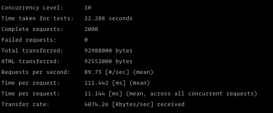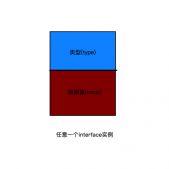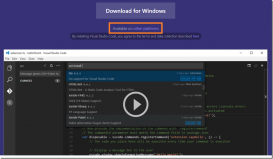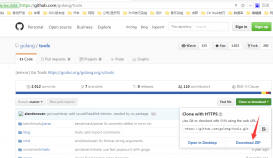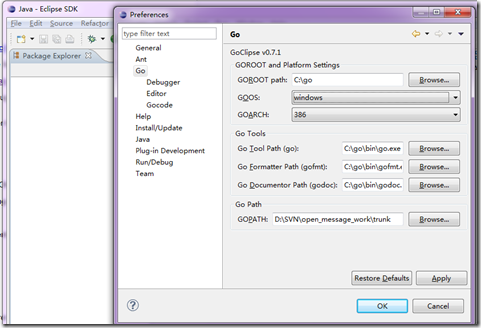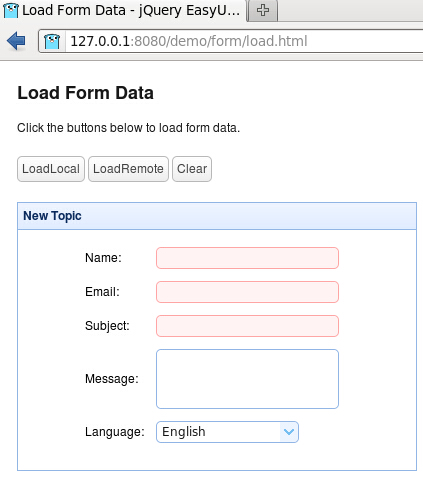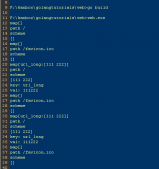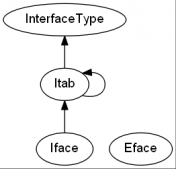什么是反射
大多数时候,Go中的变量,类型和函数非常简单直接。当需要一个类型、变量或者是函数时,可以直接定义它们:
|
1
2
3
4
5
6
7
8
9
10
|
type Foo struct { A int B string}var x Foofunc DoSomething(f Foo) { fmt.Println(f.A, f.B)} |
但是有时你希望在运行时使用变量的在编写程序时还不存在的信息。比如你正在尝试将文件或网络请求中的数据映射到变量中。或者你想构建一个适用于不同类型的工具。在这种情况下,你需要使用反射。反射使您能够在运行时检查类型。它还允许您在运行时检查,修改和创建变量,函数和结构体。
Go中的反射是基于三个概念构建的:类型,种类和值(Types Kinds Values)。标准库中的reflect包提供了 Go 反射的实现。
反射变量类型
首先让我们看一下类型。你可以使用反射来调用函数varType := reflect.TypeOf(var)来获取变量var的类型。这将返回类型为reflect.Type的变量,该变量具有获取定义时变量的类型的各种信息的方法集。下面我们来看一下常用的获取类型信息的方法。
我们要看的第一个方法是Name()。这将返回变量类型的名称。某些类型(例如切片或指针)没有名称,此方法会返回空字符串。
下一个方法,也是我认为第一个真正非常有用的方法是Kind()。Type是由Kind组成的---Kind 是切片,映射,指针,结构,接口,字符串,数组,函数,int或其他某种原始类型的抽象表示。要理解Type和Kind之间的差异可能有些棘手,但是请你以这种方式来思考。如果定义一个名为Foo的结构体,则Kind为struct,类型为Foo。
使用反射时要注意的一件事:反射包中的所有内容都假定你知道自己在做什么,并且如果使用不正确,许多函数和方法调用都会引起 panic。例如,如果你在reflect.Type上调用与当前类型不同的类型关联的方法,您的代码将会panic。
如果变量是指针,映射,切片,通道或数组变量,则可以使用varType.Elem()找出指向或包含的值的类型。
如果变量是结构体,则可以使用反射来获取结构体中的字段数,并从每个字段上获取reflect.StructField结构体。 reflection.StructField为您提供了字段的名称,标号,类型和结构体标签。其中标签信息对应reflect.StructTag类型的字符串,并且它提供了Get方法用于解析和根据特定key提取标签信息中的子串。
下面是一个简单的示例,用于输出各种变量的类型信息:
|
1
2
3
4
5
6
7
8
9
10
11
12
13
14
15
16
17
18
19
20
21
22
23
24
25
26
27
28
29
30
31
32
33
34
35
36
37
38
39
40
41
42
|
type Foo struct { A int `tag1:"First Tag" tag2:"Second Tag"` B string}func main() { sl := []int{1, 2, 3} greeting := "hello" greetingPtr := &greeting f := Foo{A: 10, B: "Salutations"} fp := &f slType := reflect.TypeOf(sl) gType := reflect.TypeOf(greeting) grpType := reflect.TypeOf(greetingPtr) fType := reflect.TypeOf(f) fpType := reflect.TypeOf(fp) examiner(slType, 0) examiner(gType, 0) examiner(grpType, 0) examiner(fType, 0) examiner(fpType, 0)}func examiner(t reflect.Type, depth int) { fmt.Println(strings.Repeat("\t", depth), "Type is", t.Name(), "and kind is", t.Kind()) switch t.Kind() { case reflect.Array, reflect.Chan, reflect.Map, reflect.Ptr, reflect.Slice: fmt.Println(strings.Repeat("\t", depth+1), "Contained type:") examiner(t.Elem(), depth+1) case reflect.Struct: for i := 0; i < t.NumField(); i++ { f := t.Field(i) fmt.Println(strings.Repeat("\t", depth+1), "Field", i+1, "name is", f.Name, "type is", f.Type.Name(), "and kind is", f.Type.Kind()) if f.Tag != "" { fmt.Println(strings.Repeat("\t", depth+2), "Tag is", f.Tag) fmt.Println(strings.Repeat("\t", depth+2), "tag1 is", f.Tag.Get("tag1"), "tag2 is", f.Tag.Get("tag2")) } } }} |
变量的类型输出如下:
|
1
2
3
4
5
6
7
8
9
10
11
12
13
14
15
16
17
18
19
|
Type is and kind is slice Contained type: Type is int and kind is int Type is string and kind is string Type is and kind is ptr Contained type: Type is string and kind is string Type is Foo and kind is struct Field 1 name is A type is int and kind is int Tag is tag1:"First Tag" tag2:"Second Tag" tag1 is First Tag tag2 is Second Tag Field 2 name is B type is string and kind is string Type is and kind is ptr Contained type: Type is Foo and kind is struct Field 1 name is A type is int and kind is int Tag is tag1:"First Tag" tag2:"Second Tag" tag1 is First Tag tag2 is Second Tag Field 2 name is B type is string and kind is string |
Run in go playground: https://play.golang.org/p/lZ97yAUHxX
使用反射创建新实例
除了检查变量的类型外,还可以使用反射来读取,设置或创建值。首先,需要使用refVal := reflect.ValueOf(var) 为变量创建一个reflect.Value实例。如果希望能够使用反射来修改值,则必须使用refPtrVal := reflect.ValueOf(&var);获得指向变量的指针。如果不这样做,则可以使用反射来读取该值,但不能对其进行修改。
一旦有了reflect.Value实例就可以使用Type()方法获取变量的reflect.Type。
如果要修改值,请记住它必须是一个指针,并且必须首先对其进行解引用。使用refPtrVal.Elem().Set(newRefVal)来修改值,并且传递给Set()的值也必须是reflect.Value。
如果要创建一个新值,可以使用函数newPtrVal := reflect.New(varType)来实现,并传入一个reflect.Type。这将返回一个指针值,然后可以像上面那样使用Elem().Set()对其进行修改。
最后,你可以通过调用Interface()方法从reflect.Value回到普通变量值。由于Go没有泛型,因此变量的原始类型会丢失;该方法返回类型为interface{}的值。如果创建了一个指针以便可以修改该值,则需要使用Elem().Interface()解引用反射的指针。在这两种情况下,都需要将空接口转换为实际类型才能使用它。
下面的代码来演示这些概念:
|
1
2
3
4
5
6
7
8
9
10
11
12
13
14
15
16
17
18
19
20
21
22
23
24
25
|
type Foo struct { A int `tag1:"First Tag" tag2:"Second Tag"` B string}func main() { greeting := "hello" f := Foo{A: 10, B: "Salutations"} gVal := reflect.ValueOf(greeting) // not a pointer so all we can do is read it fmt.Println(gVal.Interface()) gpVal := reflect.ValueOf(&greeting) // it's a pointer, so we can change it, and it changes the underlying variable gpVal.Elem().SetString("goodbye") fmt.Println(greeting) fType := reflect.TypeOf(f) fVal := reflect.New(fType) fVal.Elem().Field(0).SetInt(20) fVal.Elem().Field(1).SetString("Greetings") f2 := fVal.Elem().Interface().(Foo) fmt.Printf("%+v, %d, %s\n", f2, f2.A, f2.B)} |
他们的输出如下:
|
1
2
3
|
hellogoodbye{A:20 B:Greetings}, 20, Greetings |
Run in go playground https://play.golang.org/p/PFcEYfZqZ8
反射创建引用类型的实例
除了生成内置类型和用户定义类型的实例之外,还可以使用反射来生成通常需要make函数的实例。可以使用reflect.MakeSlice,reflect.MakeMap和reflect.MakeChan函数制作切片,Map或通道。在所有情况下,都提供一个reflect.Type,然后获取一个reflect.Value,可以使用反射对其进行操作,或者可以将其分配回一个标准变量。
|
1
2
3
4
5
6
7
8
9
10
11
12
13
14
15
16
17
18
19
20
21
22
23
24
25
26
|
func main() { // 定义变量 intSlice := make([]int, 0) mapStringInt := make(map[string]int) // 获取变量的 reflect.Type sliceType := reflect.TypeOf(intSlice) mapType := reflect.TypeOf(mapStringInt) // 使用反射创建类型的新实例 intSliceReflect := reflect.MakeSlice(sliceType, 0, 0) mapReflect := reflect.MakeMap(mapType) // 将创建的新实例分配回一个标准变量 v := 10 rv := reflect.ValueOf(v) intSliceReflect = reflect.Append(intSliceReflect, rv) intSlice2 := intSliceReflect.Interface().([]int) fmt.Println(intSlice2) k := "hello" rk := reflect.ValueOf(k) mapReflect.SetMapIndex(rk, rv) mapStringInt2 := mapReflect.Interface().(map[string]int) fmt.Println(mapStringInt2)} |
使用反射创建函数
反射不仅仅可以为存储数据创造新的地方。还可以使用reflect.MakeFunc函数使用reflect来创建新函数。该函数期望我们要创建的函数的reflect.Type,以及一个闭包,其输入参数为[]reflect.Value类型,其返回类型也为[] reflect.Value类型。下面是一个简单的示例,它为传递给它的任何函数创建一个定时包装器:
|
1
2
3
4
5
6
7
8
9
10
11
12
13
14
15
16
17
18
19
20
21
22
23
24
25
26
27
28
29
30
31
32
33
34
35
36
|
func MakeTimedFunction(f interface{}) interface{} { rf := reflect.TypeOf(f) if rf.Kind() != reflect.Func { panic("expects a function") } vf := reflect.ValueOf(f) wrapperF := reflect.MakeFunc(rf, func(in []reflect.Value) []reflect.Value { start := time.Now() out := vf.Call(in) end := time.Now() fmt.Printf("calling %s took %v\n", runtime.FuncForPC(vf.Pointer()).Name(), end.Sub(start)) return out }) return wrapperF.Interface()}func timeMe() { fmt.Println("starting") time.Sleep(1 * time.Second) fmt.Println("ending")}func timeMeToo(a int) int { fmt.Println("starting") time.Sleep(time.Duration(a) * time.Second) result := a * 2 fmt.Println("ending") return result}func main() { timed := MakeTimedFunction(timeMe).(func()) timed() timedToo := MakeTimedFunction(timeMeToo).(func(int) int) fmt.Println(timedToo(2))} |
你可以在goplayground运行代码https://play.golang.org/p/QZ8ttFZzGx并看到输出如下:
|
1
2
3
4
5
6
7
|
startingendingcalling main.timeMe took 1sstartingendingcalling main.timeMeToo took 2s4 |
反射是每个Go开发人员都应了解并学会的强大工具。但是使用他们可以用来做什么呢?在下一篇博客文章中,我将探讨现有库中反射的一些用法,并使用反射来创建一些新的东西。
以上就是本文的全部内容,希望对大家的学习有所帮助,也希望大家多多支持服务器之家。
原文链接:https://segmentfault.com/a/1190000021619810





